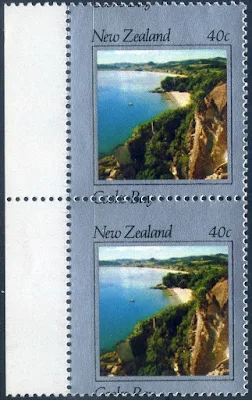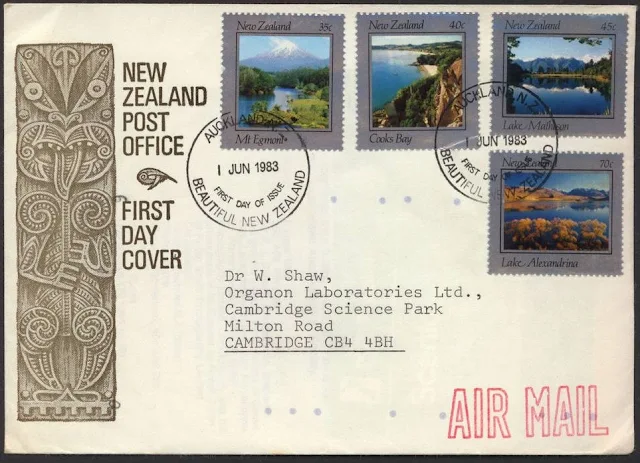This is the next post of our scenic New Zealand series. This time we view the issues of 1983 and 1984. The 1984 issue marks a bit of a change for this series, in fact I almost didn't include it in our scenic stamps collection. Where all the issues up until here has shown actual views of New Zealand this issue moved to drawings of scenic areas. I'm not sure how well this fits but since most catalogues seem to place the 1984 in the scenic series we've chosen to do the same.
1983 Scenic Stamps - Beautiful New Zealand.
See the full collection Scenic Stamps Series - Part One.
35c - Mt Egmont / Taranaki. 40c - Cooks Bay.
35c - Mount Egmont, Taranaki.
Mount Egmont which is located on the West Coast of the North Island is an andesite (mineral rock) volcano characterised, like Fujiama in Japan, by its symmetrical cone. Mount Egmont is regarded as a dormant volcano having last erupted about 350 years ago. The peak rises to 2518 metres from the plains of the surrounding province, Taranaki. In 1900 the mountain became the feature of New Zealand's second National Park.
Egmont was named in 1770 by explorer James Cook as he sailed past but the Maori name Taranaki (Barren Mountain) was given equal and official status in 1986.
40c - Cooks Bay, Coromandel.
Cooks Bay is a popular summer resort situated on the Coromandel Peninsula on the East Coast of the North Island. Locally, the sandy cove is known as Cooks Beach. The whole area is picturesque with golden beaches, sparkling water and native pohutukawa trees.
Located between Cooks Beach and Flaxmill Bay is Shakespeare Cliff, an interesting scenic reserve. A very short track leads to a vantage point with memorable views of Mercury Bay. At the site a cairn records the arrival in 1769 of the HMS Endeavour under the command of Lieutenant Captain Cook. "No sea can hurt her..." The famous words of Captain James Cook referring to the original H.M.S. Endeavour.
Located between Cooks Beach and Flaxmill Bay is Shakespeare Cliff, an interesting scenic reserve. A very short track leads to a vantage point with memorable views of Mercury Bay. At the site a cairn records the arrival in 1769 of the HMS Endeavour under the command of Lieutenant Captain Cook. "No sea can hurt her..." The famous words of Captain James Cook referring to the original H.M.S. Endeavour.
45c - Lake Matheson. 70c - Lake Alexandrina.
45c - Lake Matheson, West Coast.
Lake Matheson is a small bush-surrounded moraine lake on the north side of the Clearwater River near Fox Glacier on the South Island's West Coast. The lake was formed by the retreat of Fox Glacier some 14,000 years ago which left behind a massive slab of "dead" ice insulated by a deep layer of moraine gravel. In time, this separated from the mainstream of the glacier, the ice melted and the lake was created.
70c - Lake Alexandrina, South Canterbury.
Lake Alexandrina is a small and beautiful satellite of Lake Tekapo in South Canterbury. These lakes are just two of a number of glacial lakes in the South Island McKenzie country. Lake Alexandrina is a wild life refuge, an exceptional trout fishing resort, and home for the South Island Acclimatisation Society.
In 1881, 10,000 trout were brought to Mackenzie country and released into Lake Alexandrina, as well as some other lakes, creeks and streams. After the trout grew and prospered, fishing licenses were issued. Lake Alexandrina, now known for its attraction to fisherman, has a small number of fisherman's huts clustered at each end of the lake and near the outlet. Rowing boats are the only mode of transport on the lake as sail and motor boats are prohibited.
In 1881, 10,000 trout were brought to Mackenzie country and released into Lake Alexandrina, as well as some other lakes, creeks and streams. After the trout grew and prospered, fishing licenses were issued. Lake Alexandrina, now known for its attraction to fisherman, has a small number of fisherman's huts clustered at each end of the lake and near the outlet. Rowing boats are the only mode of transport on the lake as sail and motor boats are prohibited.
1983 40c Cooks Bay vertical pair with grossly misplaced perfs, best seen where the words Cooks Bay is split across two stamps.
1984 Scenic Stamps - Ski Fields.
See the full collection Scenic Stamps Series - Part One.
35c - Mount Hutt. 40c - Coronet Peak.
35c - Mount Hutt, Canterbury.
The smooth slopes of the Mount Hutt basin are clearly visible from Methven, the nearby farming town that offers a variety of accommodation, restaurants and ski hire. The sun shines even when cloud cover blocks out the views below. But when the cloud lifts, you are treated to superb views out across the Canterbury Plains to the blue Pacific Ocean beyond. The length of its skiing season - in a good year - lasts from May to early December. For the experienced skier, helicopters raise straight from the car park and head for the more advanced, thrilling runs in the nearby mountains.
40c - Coronet Peak, Queenstown.
Situated near the popular tourist resort of Queenstown in the south of the South Island it is too far from the sea to be affected by coastal weather conditions, snowfalls are light and regular with consistently good, light, powder snow. The ski field, about 16 kilometres from the town, is wide and open with its slopes offering a multitude of runs for every grade of skier. When the sun goes down, Queenstown offers restaurants, discos and cabarets to keep you occupied till bedtime. If you cannot get to the slopes there is a never-ending range of activities to keep you entertained such as jet boating, lake cruises, horse trekking, rafting, bungy jumping and scenic flights.
45c - Turoa. 70c - Whakapapa.
45c - Turoa, Mount Ruapehu.
Lying on the south-western slopes of Mount Ruapehu in the centre of the North Island, Turoa is New Zealand's newest ski resort. Turoa is away from the direct sun, and the high quality, dry snow stays light and crisp from June to late November. Boasting the highest vertical rise in Australasia of 720 metres the 4 kilometre run offers some of New Zealand's most diverse skiing opportunities. While the more challenging runs are on the ski field boundaries, there is an added bonus of exhilarating runs down the Mangateitei Glacier.
70c - Whakapapa, Mount Ruapehu.
Basking in direct sunlight on the northern slopes of Mount Ruapehu, Whakapapa is one of the oldest established ski fields in the country. This field offers an exciting and varied ski area with something for all grades of skiers and boasts an extensive range of lifts and other facilities, catering for a daily patronage of up to 8,500. The few hours it takes to climb to Mount Ruapehu's sulphuric crater lake are rewarded with views over some of New Zealand's most wonderful scenery. In clear weather Lake Taupo is visible to the north; the forested Kaimanawa Ranges lie east; and Mount Egmont rises majestically in the west. If the weather turns unpleasant there is whitewater rafting, trout fishing, deer hunting, golf, horse trekking, jet boating or relaxing in the hot pools at Tokaanu.
Technical information - 1983 Beautiful New Zealand.
Date of Issue:
| 1 June 1983 |
|---|---|
Designer:
| P Durrant, Christchurch |
Printers:
| Heraclio Fournier, Spain |
Stamp Size:
| 32mm x 35.5mm |
Sheet Size:
| 100 stamps per sheet |
Process:
| Photogravure |
| Perforation Gauge: | 35c and 40c: 13.25 x 13; 45c and 70c: 13 x 13.25 |
Paper Type:
| Unwatermarked |
Technical information - 1984 Sky Fields.
Date of Issue:
|
6 June 1984
|
|---|---|
Designer:
|
D Little, Auckland
|
Printers:
|
Cambec Press, Australia
|
Stamp Size:
|
34mm x 30mm
|
Sheet Size:
|
100 stamps per sheet
|
Process:
|
Lithography
|
| Perforation Gauge: |
13.6 x 13.3
|
Paper Type:
|
Unwatermarked
|
Some of the images in this post were used with permission from the illustrated catalogue of StampsNZ
You can visit their web site and On-line Catalogue at, http://stampsnz.com/












We appreciate your engagement with our content. To ensure a respectful and constructive community, please take note of the following:
- No Spam, Please: We do not tolerate spammy or promotional comments. Any such comments will be promptly removed.
- Moderation in Place: All comments are moderated to maintain a positive and inclusive environment. Please be patient, as it may take a little time for your comment to appear.
- Sign In with Google: To comment, please sign in using your Google account. This helps us maintain the integrity of our community and allows for better interaction.